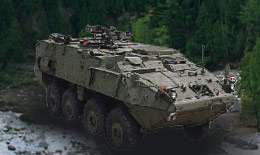M1135 Nuclear, Biological, Chemical, Reconnaissance Vehicle
The M1135 Nuclear, Biological, Chemical Reconnaissance Vehicle (NBCRV) provides nuclear, biological and chemical detection and surveillance for battlefield hazard visualization.
| M1135 NBC Reconnaissance Vehicle | |
|---|---|
 | |
| Type | CBRN reconnaissance vehicle |
| Place of origin | United States |
| Specifications | |
| Mass | 15+ t |
| Length | 6.95 m (22.92 ft) |
| Width | 2.72 m (8.97 ft) |
| Height | 2.64 m (8.72 ft) |
| Crew | 4[1] |
| Armor | 14.5 mm resistant[2] |
| Engine | Caterpillar 3126 turbo diesel 260 kW (350 hp) |
| Power/weight | 15 kW/t (19 hp/sh tn) |
| Suspension | 8×8 wheeled |
Operational range | 500 km (300 mi) |
| Maximum speed | 100 km/h (62 mph)[2] |
The NBCRV provides situational awareness to increase the combat power of the Stryker Brigade Combat Team (SBCT).[3] The core of the NBCRV is its on-board integrated NBC sensor suite and integrated meteorological system. An NBC positive overpressure system (where interior air pressure is higher than ambient air pressure outside, rather than vice versa) minimizes cross-contamination of samples and detection instruments, provides crew protection, and allows extended operations at MOPP 0. It replaces the M93 Fox vehicle.
The NBCRV detects and collects chemical and biological contamination in its local environment on the move through point detection (Chemical Biological Mass Spectrometer (CBMS) and Joint Biological Point Detection System (JBPDS)), and at a distance through the use of a standoff detector (JSLSCAD) . It automatically integrates contamination information from detectors with input from on-board navigation and meteorological systems and automatically transmits digital NBC warning messages through the Mission Command System.
As of 2010, the U.S. Army does not plan to field Stryker Double V-Hull (DVH) versions of the NBCRV in Afghanistan.[4]
Chemical Biological Mass Spectrometer (CBMS), built by Hamilton Sundstrand, is a detection system for chemical warfare agents and biological warfare agents. CBMS was originally developed by a team led by Oak Ridge National Laboratory.
On 25 July 2013, Iraq requested the sale of 50 M1135 NBC Reconnaissance Vehicles for $900 million.[5]
In October 2013, the U.S. Army decided to reduce the overall number of M1135 Strykers it will procure from 417 to 307 vehicles.[6]
References
![]()
- U.S. Army (2010). "M1135 Stryker Nuclear, Biological, and Chemical Reconnaissance Vehicle (NBCRV)" (PDF). Archived from the original (PDF) on 19 March 2012. Retrieved 22 May 2011.
A NBCRV team consists of a Stryker NBCRV and a four person crew
- "Army Fact File - Stryker". Retrieved 2008-04-16.
- Army overview Archived May 16, 2008, at the Wayback Machine
- U.S. Army. "Stryker Family of Vehicles – Double V-Hull (DVH)". Archived from the original on 23 May 2011. Retrieved 22 May 2011.
At present, the Army does not plan to field Stryker DVH versions of the Mobile Gun System (MGS) and the Nuclear, Biological, Chemical Reconnaissance Vehicle (NBCRV) in the OEF theater of operation.
- DSCA news release Archived 2013-08-06 at the Wayback Machine - DCSA.mil, 25 July 2013
- Army plans radical upgrade of Stryker brigades Archived January 12, 2014, at the Wayback Machine - Militarytimes.com, 12 January 2014
See also
| Wikimedia Commons has media related to M1135 Nuclear, Biological, Chemical Reconnaissance Vehicle. |
